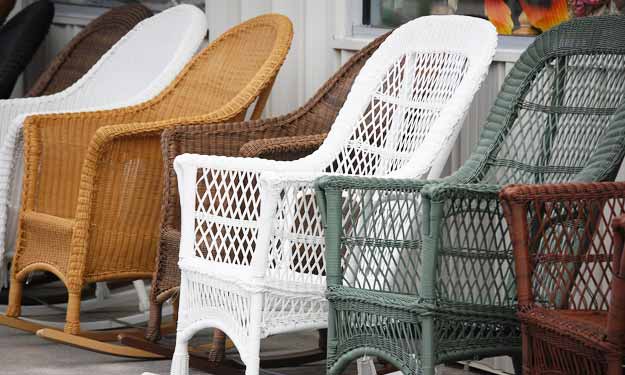Cleaning Outdoor Wicker Furniture

Tips for Cleaning Outdoor Wicker Furniture.
How to Clean Outdoor Wicker Furniture
Many people are surprised when they find out wicker isn’t a material, but rather a weaving process. Wicker items can be made up of many different materials, such as bamboo, willow branches, grasses or resin (which resembles plastic). However, the most common material used to weave wicker furniture is rattan since it is highly durable.
You might be a little hesitant about cleaning wicker as the tight weave of the wicker makes cleaning time consuming and challenging but don’t abandon your furniture to the elements. A little maintenance and regular cleaning will keep it looking great for years to come.
Maintaining Wicker Furniture
Wicker requires maintenance and upkeep to stay in tip-top shape. Here are some tips to help you out:
- As dust and debris can accumulate on outdoor wicker furniture, it’s important to clean it on a regular basis. Use a soft broom, a soft brush, a paint brush, a can of compressed air, a toothbrush or a vacuum with a soft brush attachment. This will help before debris has a chance to work into the weave of the wicker furniture.
- Wicker furniture is best if used indoors but when used outdoors, it’s best if it is under a covered area to protect it from the elements such as rain, sunlight, extreme temperature changes, etc. Keeping it covered when not in use will keep it clean and free from damage.
- It is recommended to dust wicker furniture regularly. It will make cleaning much easier and extend the life of the wicker as dust will build up and make the wicker feel almost sticky. You can remove dust easily by wiping wicker with a slightly damp cloth.
- Check wicker furniture periodically for signs of damage, such as loose weaves or broken strands. Repair any minor damage to prevent it from worsening.
- Avoid excessive moisture. Do not place wicker on wet surfaces. Do not leave in areas with high humidity. If any part of the wicker gets wet, wipe it dry to prevent mold or mildew growth.
- When cleaning wicker furniture with any type of liquids, work in small sections at a time so you can dry as you go (you can also use a fan to help with the drying process). It is also a good idea to not sit on the piece until it is completely dry as you do not want the wicker to sag.
Removing Dirt and Grime from Wicker
When wicker has been neglected for a while, you will need to spend a bit more time in order to get the item clean. Take care not to soak wicker with water as this can cause warping.
1. First, remove dirt by vacuuming between the cracks and crevices with a soft brush attachment. If necessary, use tweezers, a toothbrush or a dry paint brush to get to the places your vacuum can’t get clean.
2. Once the dirt is removed from wicker, use warm soapy water; using either a mild detergent or dish soap to clean the grime, and begin to gently clean the wicker with a soft cloth or sponge.
3. Pay attention to stains and heavily soiled areas. If necessary, use a toothbrush or a paint brush to get into tight areas.
Removing Mold and Mildew from Wicker
Humidity, dampness and rain can cause mold and mildew on wicker furniture. If you need to remove mold or mildew follow the instructions below. Wear gloves, protective eye wear and a face mask to avoid any irritations. When cleaning to do not apply excessive amounts of pressure and do not scrub too hard.
- From the surface of the wicker, brush off what mold or mildew you can using a soft bristled brush.
- Either mix a 50/50 solution of white vinegar and water or a mix a solution of 1 part bleach to 3 parts water. Do not mix bleach and vinegar together. Either of these are quite effective at killing mold and mildew.
- Place some of the mix in a spray bottle then spray the affected areas and let sit about 10 minutes.
- Use a sponge, toothbrush or soft bristled brushed to gently clean the areas with mold or mildew.
- Make sure to rinse your furniture thoroughly with fresh clean water to remove all traces of the cleaning solution.
- Run a dry towel over the surface to remove remaining traces of water.
Keep in mind that if mold and mildew cover large areas of the wicker furniture, you may need to treat it several times before it is fully removed.
Removing Stains from Wicker Furniture
Removing stains from wicker can be a challenge if left to sit for any period of time, so be sure to act quickly.
- Wipe up stains as soon as they happen. Again, avoid rubbing to hard to prevent damage.
- In a bowl of warm water, mix in a mild dish detergent or dish soap.
- Dab the stained area with the warm soapy water.
- Rinse with clean water.
- Dry thoroughly.
- Repeat if necessary.
For tough stains, try using the same bleach or vinegar solution used for removing mold and mildew.
Retouching, Repainting, Refinishing Wicker Furniture
If you’ve tried cleaning your wicker furniture and that doesn’t work to remove stains or if the painted wicker has become chipped or if the protective finish is wearing off, another option is to put a fresh coat of paint or varnish on the wicker.
Choose a paint or varnish that is suitable for the wicker furniture. If necessary, start with a primer to cover up stains and then use a paint in the color of your choice.
To keep wicker looking its best, cleaning should be done on a regular basis. A few moments spent cleaning can greatly increase the life and beauty of your wicker furniture.






